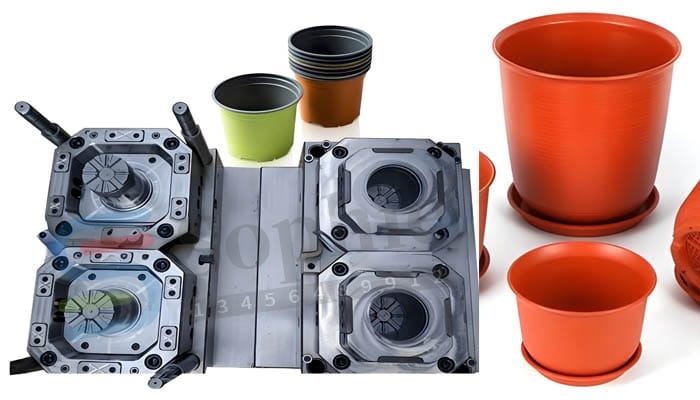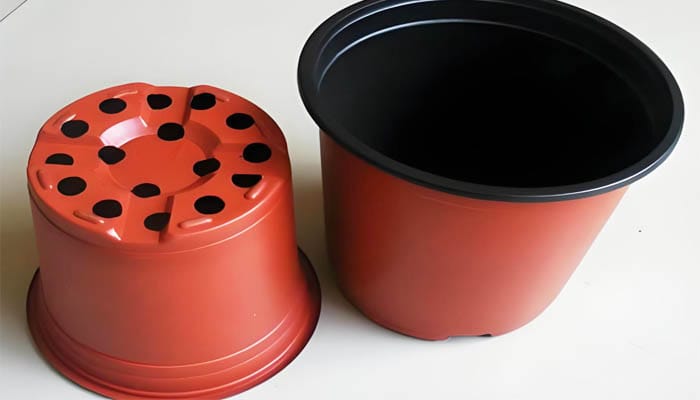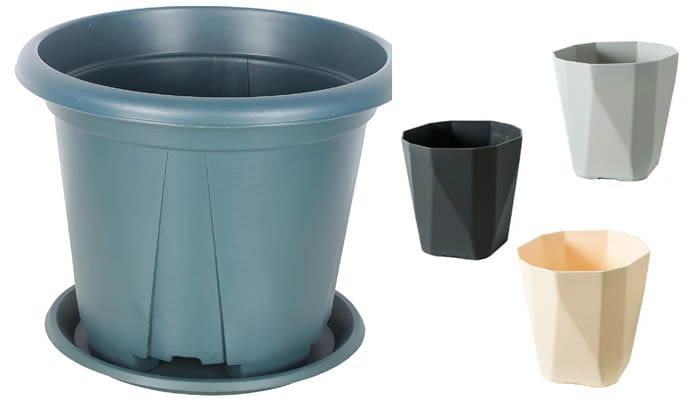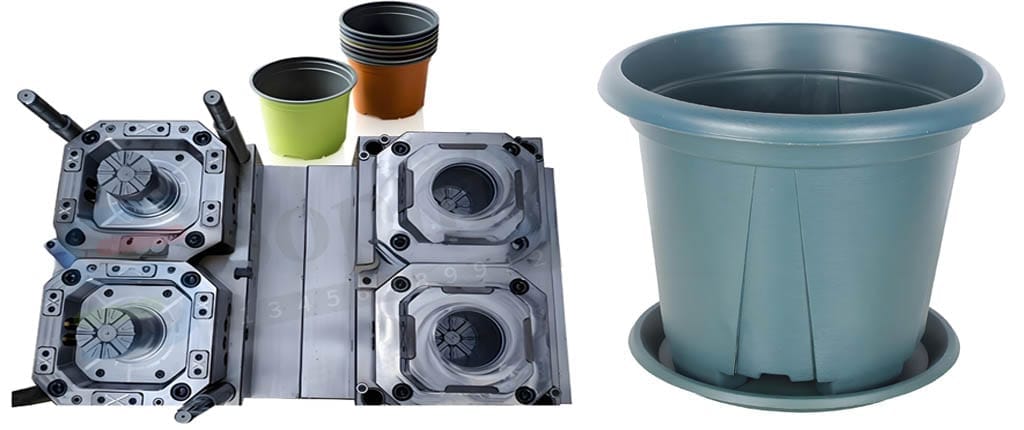Principles of plastic flower pot mold design
In modern gardening and urban greening, plastic flower pots are becoming more and more popular because of their lightness, durability and cost-effectiveness. However, to produce plastic flower pots that are both beautiful and practical, plastic flower pot mold design is a crucial link. This article will explore the key elements of plastic flower pot mould design to ensure product quality and production efficiency.
Table of Contents
ToggleMaterial selection and property understanding
When designing a plastic flower pot mold, you must have an in-depth understanding of the plastic materials used. Common plastic materials include polypropylene (PP), polyethylene (PE), polyvinyl chloride (PVC), etc. Each material has its own unique physical and chemical properties, such as melting point, fluidity, shrinkage, etc. These properties directly affect the mold design and molding process.
Mold opening direction and parting line
Each injection molding plastic flower pot must first determine its mold opening direction and parting line when it starts to be designed, so as to minimize the core pulling slider mechanism and eliminate the impact of the parting line on the appearance.
1. After the mold opening direction is determined, the flower pot’s reinforcement ribs, buckles, protrusions and other structures are designed to be consistent with the mold opening direction as much as possible to avoid core pulling to reduce the seam line and extend the mold life.
2. After the mold opening direction is determined, an appropriate parting line can be selected to avoid undercuts in the mold opening direction to improve the appearance and performance.
Reasonable gate and runner design
The design of gate and runner is crucial for the molding of plastic flower pots. Reasonable gate design can ensure that the plastic melt fills the mold evenly, reducing bubbles and material waste. The runner design needs to consider the fluidity of the material to ensure that the melt can smoothly reach every corner of the mold.
Effectiveness of cooling system
The cooling system is a key part in the design of injection molds. Effective cooling can speed up the production cycle and improve production efficiency. For plastic flower pots, the cooling system needs to be evenly distributed to ensure that all parts of the flower pot can be evenly cooled to prevent deformation and internal stress.
Demolding slope of plastic flower pot mold
The demoulding design of plastic flower pots needs to take into account the complexity of the product and the production efficiency. A good demoulding design can reduce the scratching and deformation of the product, while reducing the need for manual intervention and increasing the possibility of automated production.
1. Appropriate demolding slope can avoid flower pot roughness (drawing). The demolding slope of smooth surface should be ≥0.5 degrees, the surface of fine leather grain (sand surface) should be greater than 1 degree, and the surface of rough leather grain should be greater than 1.5 degrees.
2. Appropriate demolding slope can avoid flower pot top damage, such as top whitening, top deformation, and top breakage.
3. When designing deep cavity structure products, the outer surface slope should be greater than the inner surface slope as much as possible to ensure that the mold core is not offset during injection molding, obtain uniform product wall thickness, and ensure the material strength of the product opening.


Product wall thickness
1. All kinds of plastics have a certain range of wall thickness, generally 0.5 to 4 mm. When the wall thickness exceeds 4 mm, it will cause the cooling time to be too long, resulting in shrinkage and other problems. Consider changing the product structure.
2. Uneven wall thickness will cause surface shrinkage.
3. Uneven wall thickness will cause pores and weld marks.
Reinforcement Ribs
1. Reasonable application of reinforcement ribs can increase product rigidity and reduce deformation.
2. The thickness of the reinforcement rib must be ≤ (0.5-0.7)T product wall thickness, otherwise it will cause surface shrinkage.
3. The single-sided slope of the reinforcement rib should be greater than 1.5° to avoid top injury.
Fillet
1. Too small fillet may cause product stress concentration, resulting in product cracking.
2. Too small fillet may cause mold cavity stress concentration, resulting in cavity cracking.
3. Setting reasonable fillet can also improve the processing technology of the mold, such as the cavity can be directly processed by R cutter milling, avoiding inefficient electrical processing.
4. Different fillets may cause the movement of the parting line, and different fillets or corner clearances should be selected according to actual conditions.
Hole
1. The shape of the hole should be as simple as possible, generally circular.
2. The axial direction of the hole is consistent with the mold opening direction, which can avoid core pulling.
3. When the aspect ratio of the hole is greater than 2, the demoulding slope should be set. At this time, the diameter of the hole should be calculated according to the minor diameter size (maximum physical size).
4. The aspect ratio of the blind hole is generally not more than 4. Anti-hole needle punching
5. The distance between the hole and the edge of the product is generally greater than the hole diameter size.


Precise Dimensions and Tolerances
The dimensions and tolerances of plastic flower pots are elements that require precise control during design. The size of the flower pot not only affects its appearance, but also relates to the growing space for the plants. Therefore, the mold design must ensure that the design dimensions can be accurately replicated during the injection molding process, while taking into account the shrinkage of the material to ensure the dimensional accuracy of the finished product.
Due to the unevenness and uncertainty of shrinkage during injection molding, the precision of injection molded flower pot is significantly lower than that of metal parts. The dimensional tolerance of mechanical parts cannot be simply applied. Appropriate tolerance requirements should be selected according to the standard. my country also issued GB/T14486-93 “Dimensional Tolerance of Engineering Plastic Molding Plastic Parts” in 1993. Designers can determine the dimensional tolerance of parts according to the plastic raw materials used and the use requirements of the parts according to the provisions in the standard. At the same time, the appropriate design tolerance accuracy should be determined based on the comprehensive strength of the factory and the design accuracy of the products of the same industry.
Consider the contradiction between process and flower pot performance
1 When designing injection molded flower pots, the contradiction between product appearance, performance and process must be comprehensively considered. Sometimes sacrificing some processability can get a good appearance or performance.
2 When the structural design cannot avoid injection molding defects, try to make the defects occur in the hidden parts of the product.
WS Mold design principles
1. The pillars should not be used alone. They should be connected to the outer wall or used together with reinforcing ribs. The purpose is to strengthen the strength of the pillars and make the rubber flow smoother.
2. The height of the pillar is generally not more than two and a half times the diameter of the pillar. Because pillars that are too high will cause air to be trapped during molding of plastic parts (too long will cause pores, scorching, insufficient filling, etc.).
3. If the height of the pillar exceeds two and a half times the diameter of the pillar, especially the pillar far away from the outer wall, the method to strengthen the pillar is to use reinforcing ribs
4. The shape of WS MOLD is mainly round, and other shapes are difficult to process.
5. The location of the WS MOLD should not be too close to the corner or the outer wall, and should be kept at a distance from the outer wall of the product.
6) Some of the thickness around the WS MOLD can be removed (i.e., the crater is opened) to prevent shrinkage and subsidence.
7). WS’s mold dialing angle: usually 0.5° for the outside and 0.5° or 1 for the inside.


Plastic flower pot mold design is a complex process involving multiple fields such as material science, mechanical engineering, and environmental science. Through precise material selection, size control, gate and runner design, cooling system, demoulding design, durability and maintenance, environmental adaptability, and innovation and sustainability, a plastic flower pot mold that is both beautiful and practical can be designed. This can not only improve production efficiency and reduce costs, but also meet the market demand for high-quality plastic flower pots and contribute to gardening and urban greening.


